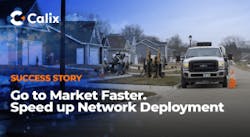Executive Insights With Jeff Storey, President and CEO, CenturyLink
TOPIC: YOU —
ISE: Some have described you as a nuanced leader with an understanding that running a successful telecom company is not black and white. They say you can see the many shades of gray, and execution is your strong suit. How would you describe yourself?
Storey: I think of myself as an engineer. I start with what I want to accomplish, look at what I know and don’t know, break complex problems into their smallest components, and get started on the first one. If there is nuance, it’s that while there may be one right answer, there are often multiple ways of getting to it. Engineers focus on efficiency and effectiveness. If we do that as managers and leaders, good execution is a natural outcome.
TOPIC: YOUR ROLE
ISE: What is the most interesting thing about your role at CenturyLink? What would you recommend to someone who wants to achieve such a high-level position in their career?
Storey: Focus on people. Whether it’s employees, customers, or shareholders, we are all people. We have very specific wants and desires, and things that motivate and demotivate us. We can’t do anything alone. In my role at CenturyLink, it’s really how well I can describe where we are going, convince our employees and customers that’s the right direction, and align our company to accomplish our goals.
Also, be yourself. We are all unique individuals. When I’m being myself, it’s natural and real. If I try to play a role or be what people might expect of me, it’s unnatural and awkward. It’s hard to relate to other people if you’re not being true to yourself first.
Storey: CenturyLink is the accumulation of many different companies. As a result, we have network equipment from a variety of technologies and a variety of vendors. However, the core value of our company is the massive fiber optic infrastructure we own. While we will continue to heavily invest in and expand our fiber footprint, it is the equipment we deploy and how we interact with that equipment that will continue to transform our products, services and operations.
I believe we have an ability to go beyond the current state-of-the-art. That means embracing SDN and NFV technologies, and upgrading equipment to give a common platform in every building and every city and every country where we operate. There should not be a separation between operational support systems and networks. They are no longer two distinct things; instead, they are really two integrally related aspects of the same network.
TOPIC: INSPIRATION
ISE: Share a quote from someone who inspires you.
Storey: "Beyond genius is simplicity." -Albert Einstein
TOPIC: SUBTLETIES
ISE: Share your thoughts about this quote: "A boss has the title; a leader has the people." (Source: Simon Sinek)
Storey: It’s a good quote. If I have to tell people what to do (use my title), I’ve probably already lost. Certainly, I won’t have the benefit of their wisdom. If I get our people aligned around a common vision they believe in and that they see themselves in, they figure out how to make it happen.
TOPIC: AGILITY
ISE: A business needs to run two models simultaneously: one optimized for today, and one optimized for tomorrow. How do you do that well without neglecting one or the other?
Storey: This is a good question with a simple answer, but often hard for companies to do.
Focus. You have to focus on where you are going and what you’re trying to become, but in particular, you have to focus on the employee experience and the customer experience, in that order. How can you possibly deliver a good customer experience if you don’t have a good employee experience?
A good employee experience starts with giving employees the tools and processes to do their job efficiently and effectively. We all know when we are adding value to the customer and the company. Maximize those opportunities and eliminate the non-value-add work.
If you’re listening, employees and customers will tell you where you need to go. However, you have to be listening, evaluating, and reacting. Most of the time, overcoming existing challenges leads you down the path to what you’re trying to build anyway.
TOPIC: CHANGE
ISE: How do you embrace change? If you could change one thing about CenturyLink, what would it be? What will stay the same at CenturyLink even though you’ve taken the reins?
Storey: First of all, companies and individuals don’t have a choice but to embrace change. In today’s world, if you stand still, the market will pass you by. I believe that statement is true for all industries, but it is certainly true for technology companies like CenturyLink.
I think the harder challenge is how do you get an organization to embrace risk. You can’t change without risk and we are all afraid of failure. The first step is to always face the truth that standing still is guaranteed failure.
When looking backward to determine success or failure, evaluating the decision-making process is often more important than evaluating the outcome. Did I ask the right questions? Did I get input from all the right people? Did I make the decision in a timely manner? That last aspect is critically important. I can be right 100% of the time — just wait until the market determines the answer and then go along with it. Unfortunately, that means you’ve probably already lost.
TOPIC: OVERLOOKED ISSUES
ISE: What should all of us in the Information and Communication Technology industry be talking about that we are not?
Storey: I don’t know that we are overlooking the issue, but the fundamental question we need to answer is How do we make it easier for our customers to consume our services? There is no question that customers need our capabilities. It’s just a question of how we make it easier for them.
TOPIC: ACQUISITIONS AND INTEGRATION
ISE: Share your greatest lesson learned from the many acquisition processes you’ve led. What is the hardest to manage? How does this impact culture? What could be improved when providers acquire other companies with network and human capital assets?
Storey: While physical assets are great, people make the difference! With any acquisition, you have to help people understand the vision of what you’re creating, and then help them see themselves and how their job contributes to that vision.
You also have to foster change without judgment. Technology has changed, tools have changed, customer needs have changed. The fact that a company has to change to keep pace should be interpreted in that context — not that change is an indication of failed decisions in the past. The most terrifying statement I hear is "We can’t do that because that’s not the way we’ve done it in the past."
InvisiLight® Solution for Deploying Fiber
April 2, 2022Go to Market Faster. Speed up Network Deployment
April 2, 2022Episode 10: Fiber Optic Closure Specs Explained…
April 1, 2022Food for Thought from Our 2022 ICT Visionaries
April 1, 2022TOPIC: FIBER AND 5G
More than ever, consumer habits are fueling the growth of mobile video, data, IoT, and A.I. As a result, there is no stopping the strain on the fixed and mobile networks. And with 5G networks being rolled out by AT&T and Verizon in select cities, the challenges will build exponentially. That means more fiber in more places across varied topologies. It means field challenges, cost challenges, and even people challenges.
ISE: Why is that not happening faster? What is needed for fiber densification, fiber to rural areas, and fiber to meet the needs of 5G sooner than later?
Storey: Market economics determine the adoption rate of all new technology. With respect to fiber densification, at CenturyLink that happens every day and on a massive scale. We are continually expanding our footprint and our capacity. 5G will come, but there are significant construction challenges ahead to build that many radio sites.
TOPIC: VIRTUALIZATION AND AUTOMATION
ISE: What is CenturyLink doing to virtualize and automate network operations, and how is that effort progressing? What is needed from the vendor community to help? Why are these efforts so critical today?
Storey: At CenturyLink, we work on virtualization and automation every single day. In fact, if we were the only ones working on it, we would still be doing exactly what we are doing. All technology is about creating gain — usually in the forms of efficiency and effectiveness. These are critical efforts because those efficiency and effectiveness gains are the key to our future success and what drive a "digital business" like CenturyLink.
Storey: A leader’s job is to create alignment to execute on a shared vision. I want to do that by helping people see themselves in that vision and by helping them see their own personal purpose for working here. We all want to do something meaningful. Fortunately for me, we do meaningful things at CenturyLink: changing people’s lives by opening them up to the digital world.
My approach is around communicating on a one-on-one level. Even in a large group I try to communicate one-on-one. Not talking at them, but really talking with them and helping our employees see their purpose in what we’re trying to accomplish as a team.
If you want to work for me, you have to be smart, hardworking, a good communicator, but fundamentally care about people. What I expect to accomplish is big and transformative. It requires the combined effort of tens of thousands of employees. If I were to surround myself with executives who don’t care about people and are poor communicators, there is no way to get those tens of thousands to work with a common objective and to see purpose in what they’re doing.
TOPIC: MYTH
ISE: What is the greatest myth about being a CEO?
Storey: You spend more time playing golf.
TOPIC: BALANCE
ISE: What do you do to help create work/life balance in your life? How does CenturyLink encourage their employees to find work/life balance?
Storey: It’s easy for any job to be all-consuming. However, that’s really the result of a lack of discipline.
Set your priorities, have activities outside of work that challenge you, and force yourself to make time to engage.
Culturally, CenturyLink believes that work/life balance creates a sustainable energy level that’s good for the company. If an employee has too much work, the person burns out and leaves or becomes less productive. With too little work, the company doesn’t get what is expected.
TOPIC: CONCISENESS
ISE: Please fill in the blank. "Satisfaction is ____________."
Storey: Delivering on your own expectations.
ISE: Please share one word that describes you.
Storey: Determined.
About the Author
Sharon Vollman
Content Ambassador for ISE EXPO
Sharon Vollman is the Content Ambassador for ISE EXPO. She is passionate about collaborating with thought leaders, SMEs and hard-working doers who design, plan and deploy ultra-reliable broadband networks. Vollman is committed to creating a variety of educational offerings for ISE EXPO attendees that inspire them to connect every U.S. citizen with the broadband networks we all want for our children and grandchildren.
Vollman has created educational partnerships with Broadband Service Providers including AT&T, Verizon, Lumen, Frontier Communications and others. She has covered the telecom industry since 1996.







